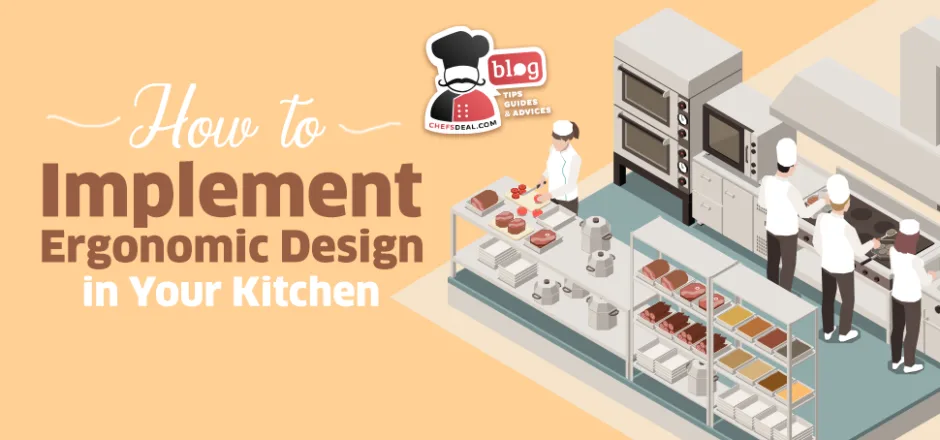Implementing ergonomic design in your kitchen is a transformative process that involves much more than just arranging appliances and tools. It’s about creating an environment that enhances functionality and comfort for those working within it.
Whether you’re revamping a commercial kitchen or designing a new one, understanding how to apply ergonomic principles is key to achieving a workspace that is both efficient and user-friendly. In this article, we’ll explore assessment and planning, as well as practical steps and strategies for incorporating ergonomic design into your kitchen, ensuring it meets the needs of your staff and contributes to a more productive and safe culinary environment.
Assessment and Planning for Ergonomic Kitchen Design
Implementing an ergonomic design in your kitchen begins with a comprehensive assessment and planning phase. Assessing how effectively the current space is utilized, especially in high-traffic areas, is vital. This stage lays the foundation for a well-organized and efficient kitchen catering to staff’s comfort and productivity. Consider if there’s enough room for staff to move comfortably and perform tasks without hindrance. Also, evaluate if the current layout allows smooth flow from one task to another, minimizing unnecessary steps or movements. Here are the 2 key steps involved in this process.
Conduct a Workspace Analysis
Evaluating the current workflow is crucial in identifying areas where staff movement is inefficient or problematic. This analysis involves mapping out the sequence of tasks and the movement of staff throughout a typical workday. Pay attention to bottlenecks or points where staff members might cross paths frequently, leading to potential disruptions or delays. Understanding these dynamics helps in reshaping the workflow for better efficiency.
Identify Areas for Improvement
One of the most effective ways to understand ergonomic challenges in a kitchen is by talking directly to the staff. They can provide valuable insights into where they experience discomfort, fatigue, or inefficiency during their shifts. Gathering this firsthand information is pivotal in designing a kitchen that addresses the specific needs and challenges of the people who use it daily and will lead to beneficial improvements.
Develop an Ergonomic Design Plan
Based on the comprehensive assessment, develop an ergonomic design plan that addresses the identified issues, prioritizing changes that will significantly impact efficiency and staff well-being. This plan should encompass rearranging equipment, redesigning workflow patterns, and possibly altering the kitchen’s physical structure if necessary. Ensure that the improvement plan is realistic, within budget constraints, and causes minimal disruption to ongoing operations.
Take Practical Steps to Implement Ergonomics
Implementing ergonomic design in a kitchen needs a convenient layout, arrangement of heights, use of ergonomically designed equipment, and changes in lighting and flooring options to create huge differences in a kitchen’s design and boost the efficiency of an operation.
Optimize Layout for Workflow Efficiency
Optimizing the layout of a commercial kitchen is crucial for enhancing workflow efficiency. This process involves strategically rearranging the space to streamline operations, reduce unnecessary movement, and improve the overall functionality of the kitchen. You can create a more cohesive and productive environment by carefully considering the placement of equipment, workstations, and storage.
Separate Workstations
Creating separate workstations for different tasks enhances productivity and efficient workflow. Allocating different areas for cooking, preparation, plating, and dishwashing with the necessary equipment avoids unnecessary movement and bottlenecks in the kitchen, letting the chefs focus on their own tasks without interfering with each other and ensuring quality food service.
Storage and Shelving
Storage has a critical role in providing an organized and efficient kitchen. Repositionable and adjustable shelves and cabinets provide facility during inventory changes and placement of new equipment. Also, easy-access cabinets and pull-out drawers allow the staff to place and retrieve items quickly. Placing shelves and racks above the workstations or equipment provides extra storage for vital goods and frees counter space.
Using the Work Triangle Concept
The kitchen work triangle is a popular layout concept in a kitchen that provides a smooth operation. It is the arrangement of the three key areas of a kitchen: cooking area, preparation area, and storage. These are the pinpoints in a kitchen that staff moves between continually. Arranging these three areas close to each other as a triangle saves unnecessary movement and reduces strain on the staff while creating a streamlined workflow, providing extra efficiency.
Equipment Usage and Placement
Equipment placement should align with how frequently it’s used. Often used equipment should be easily accessible, reducing the need for staff to walk long distances or perform awkward movements. Conversely, rarely used items can be stored out of the way. This strategic placement enhances efficiency and reduces physical strain on the staff.
Select Ergonomically Designed Equipment
The ergonomic design has taken its place in kitchen equipment designs to help reduce strain and enhance efficiency. Digital user-friendly controls, interfaces, displays, and adjustable heights of modern kitchen equipment aim to reduce the dangers of strain and injuries in a kitchen workplace. More comfortable and simple usage reduces the risk of injuries and errors and saves critical time during peak service hours.
Involve Your Team in the Process
Involving your team in planning, implementing, and improving the ergonomic design of your kitchen ensures effectiveness and increases benefits. Providing sufficient training, gathering their feedback and critiques, and empowering them to participate will improve and evolve the process.
Gather Staff Feedback
Involving staff feedback in ergonomic planning is the simplest yet the most effective way to determine the process and practices for improvement. The staff feedback can demonstrate the areas for improvement, current and possible issues in the workflow and equipment, and show if training is enough or more is necessary. This will also increase their awareness and dedication to ergonomics, leading to better results.
Train Your Staff
Training staff on making the best use of ergonomic design and other ergonomic practices in the kitchen decreases the risks of accidents and improves safety and efficiency. Basic ergonomic practices include proper working and standing postures, carrying items, and potential injuries from simple movements such as bending, lifting, and repetitive movements. Knowing these basics and proper equipment usage increases production and reduces possible risks.

Conduct Regular Review and Adjustments
After implementing ergonomic design in your kitchen, you need to conduct regular reviews and feedback to acknowledge ergonomics’ positive and negative impacts and make adjustments to ensure effectiveness.
Monitor the Impact
To monitor the impact of the ergonomic design you created in the kitchen, you should return to your plan and the goals you set at the beginning. Consider what problems and pain points you have identified before implementing the ergonomic design in your kitchen and what are the changes in productivity, safety, and quality through the metrics such as output, efficiency, turnover, absenteeism, cycle time, customer satisfaction, and safety measurements such as injuries, incidents, claims, and expenses. You can use surveys to gather information from employees and customers about their comfort, pleasure, health, and performance.
Adaptate And Evolve With Your Experiences
After assessing the effectiveness of your ergonomic changes, you should revise and improve them according to the feedback and the results. Consider if the practices met your goals, improved the deficiencies and the problems, and what points were the most effective and weak. After recognizing the inefficiencies and challenges, continuously refining and implementing changes based on required improvements will enhance your operation’s productivity, quality, safety, and performance.
Do You Need Professional Consultation for Ergonomic Kitchen Design?
Yes, professional consultation in ergonomic kitchen design is a valuable investment, especially in complex scenarios, expansions, or when seeking tailored solutions. It ensures the kitchen is efficient and a safe and comfortable workspace for all staff members. Here are the 6 possible scenarios where you can need a professional consultation.
- Complex Layouts or Major Issues
- Expert Analysis and Solutions
- Cost-Benefit Analysis
- Custom Design Solutions
- When Expanding or Remodeling
Complex Layouts and Major Overhauls
In cases where a kitchen has a complex layout or significant ergonomic issues are identified, professional advice becomes indispensable. Experts in kitchen design help you navigate these complexities more effectively. They bring extensive experience in dealing with diverse kitchen configurations and can provide innovative solutions to intricate problems.
Expert Analysis and Solutions
Professional designers offer detailed ergonomic assessment that goes beyond the surface. They are trained to identify issues that may not be immediately apparent to someone without a background in ergonomic design. Their expertise allows them to suggest innovative and effective solutions that optimize kitchen operations while ensuring staff comfort and safety.
Cost-Benefit Analysis
A professional can conduct a thorough cost-benefit analysis of proposed ergonomic improvements. This analysis helps kitchen managers or owners understand the financial implications of ergonomic changes and balance them against the potential benefits, such as increased efficiency, reduced staff turnover, and lower risk of work-related injuries.
Custom Design Solutions
Every kitchen has its unique set of challenges and needs. Professionals in ergonomic kitchen design can offer custom solutions tailored specifically to the requirements of your kitchen. This personalized approach ensures that the ergonomic improvements are effective and align with your establishment’s specific operational needs and goals.
When Expanding or Remodeling
Consulting with an ergonomic expert is highly recommended during expansion or remodeling projects. Such major changes present an opportunity to incorporate ergonomic principles right from the planning stage, leading to better outcomes. An expert can guide you in designing a layout that maximizes space utilization, improves workflow, and incorporates the latest ergonomic kitchen design, making your investment more valuable in the long term.
In summary, professional consultation for ergonomics in commercial kitchens is a valuable investment, especially in complex scenarios, expansions, or when seeking tailored solutions. It ensures that the kitchen is a place of efficiency and a safe and comfortable workspace for all staff members.

Balancing Cost and Effectiveness
When implementing ergonomic design changes in your commercial kitchen, balancing cost with effectiveness is essential. A thorough cost-benefit analysis is vital to ensure that your investment in ergonomic improvements yields tangible results without straining your budget. This involves evaluating the financial implications of proposed changes against the potential benefits, such as enhanced staff productivity, reduced injury risks, and improved operational efficiency.
By carefully assessing immediate costs and long-term gains, you can make informed decisions that enhance your kitchen’s ergonomic design while maintaining financial sustainability. This approach ensures that each ergonomic improvement aligns with your business objectives and contributes to a healthier, more efficient kitchen environment.
Conclusion
In conclusion, implementing ergonomic design in your kitchen is a complicated process that includes comprehensive assessment, strategic planning, and practical execution. You can create a more productive and comfortable kitchen environment by performing a comprehensive workstation analysis, identifying areas for improvement, and designing a specific ergonomic design plan.
Practical methods like optimizing the layout for workflow efficiency, using ergonomically designed equipment, and involving your staff in the process all contribute to a safer and more productive kitchen. Ultimately, an ongoing commitment to ergonomic improvements can transform your kitchen into an ergonomically sound and more efficient workspace that supports your kitchen team’s health, safety, and productivity and enhances the operation’s overall success.




